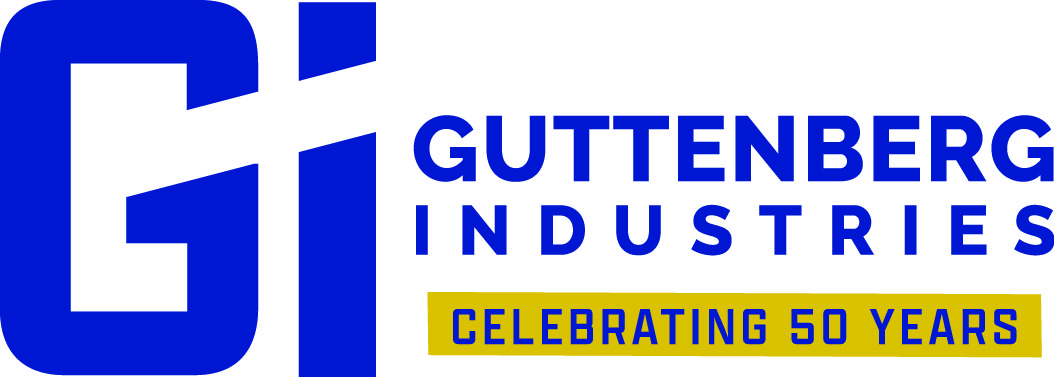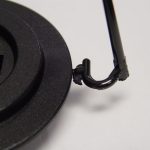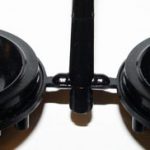Part Design Suggestions
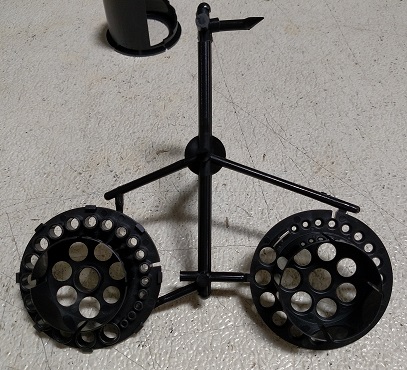 Part Design
Part Design
Our review of part design actually begins during the quoting stage. Our experienced estimating team is skilled in detecting product features that add cost and risk downstream quality problems. If we think we can save you money, suggestions are often provided during this phase.
Otherwise, a more detailed analysis is performed by a team of experts during the early hours of the product launch. This team actively searches for cost-saving opportunities and design features that might create a risk of problems later in the process. MoldFlow simulation software is used to detect potential problems, maximizing the potential for first-round success. Any ideas are communicated to you right away so that you may update the design quickly if you decide to do so. And if you don't choose to act on our suggestions, that is fine. But we will keep trying to help in any way we can.
We now even provide free online assistance with an 11-page PDF that highlights 10 design tips for injection molded parts/products as well as insights on plastic materials and tolerances.
Click here for our Top 10 Design Tips for Plastic Injection Molded Parts.
Design for Manufacturability (DFM)
Design for Manufacturability, or DFM, is a time-tested tool to help product designers minimize costs and time to market. Complex designs incur additional costs. Sometimes complexity is necessary. However, unnecessarily complex plastic injection molding designs can increase the manufacturing costs of plastic parts significantly. Our professional staff at Guttenberg Industries aims to help you use DFM in order to keep your designs as simple as possible while keeping costs to a minimum.
Get our 11-page guide including the Top 10 Design Tips for Injection Molding of Design for Manufacturability.
Tip #1 - Understanding Draft
Draft is an angle incorporated into the wall of a mold, thus the shape of the plastic part, so that the opening of the cavity is wider than its base. For those unfamiliar with draft, you might notice that plastic drinking cups are always wider at the mouth of the cup than at the bottom. This shape is a demonstration of draft. It is smaller at the base than at the mouth so that the cup will come out of the mold. Draft is essential for injection molding. The image to the right illustrates clear examples of draft, but in most cases, the draft angles are unnoticeable on parts.
Click here for more on how Understanding Draft will be important for your Injection Molding.
Tip #2 - Thicker is often Weaker for Wall Thickness
In materials such as wood or metal, thicker usually means stronger. However this is not necessarily the case with injection molded plastics. As the molten plastic cools, it also shrinks, layer by layer until each section solidifies. Plastic, however, hardens and shrinks from the outside in, and as the outer shell shrinks inward, the center is simultaneously pulled toward the outer shell. So as the material in the center of the wall cools, it is simultaneously being pulled in two opposite directions toward the outer wall on both sides.
Find out more about how important wall thickness is with our Top 10 Design Tips for Plastic Injection Molded Parts guide.
Tip #3 - Understanding Ribs and Gussets
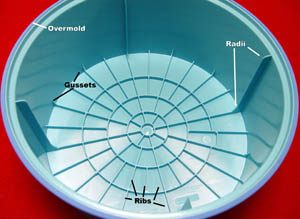 Rib
Rib
A rib is a side wall or structure of side walls that is attached to the main wall, usually at right angles. Ribs add strength and rigidity to a primary wall without the dangers and high costs caused by excessive wall thickness.
Gusset
A gusset is a triangular-shaped rib supporting a main wall. Wherever the rib intersects with the main wall, that intersection will be thicker than the other sections of the main wall. If the rib is too thick, it will cause sink marks in the main wall.
Learn more about how durability and stability are key factors to consider for your Plastic Injection Molding project. Find out more in our guide, Top 10 Design Tips for Plastic Injection Molded Parts.
Tip #4 - The Importance of Radii with Flow and Strength
During the injection molding cycle, molten plastic is injected into the space between the two halves of the mold. As the molten plastic flows into this gap, it encounters a labyrinth of metal that it must flow past. If the edges of this metal are sharp, it causes excessive sheer heat in the plastic, which can damage the plastic and weaken the molded part. All of this is easily avoided by incorporating radii into your part design.
Did you know that by adding a Radius can help to reduce each corner? Check out our 11-page guide, Top 10 Design Tips for Plastic Injection Molded Parts.
Tip #5 - Gate Locations
The location where the molten plastic material flows into the space between the two halves of the mold is called a gate. Every injection-molded part has at least one gate, and some have several gates. The type of gate and location of the gate is driven by the shape of the part and the customer's preferences for tool and piece price. There are pros and cons to each type of gate.
Click here for our Top 10 Design Tips for Plastic Injection Molded Parts with additional information on selecting the gate type and location and so much more.
Tip #6 - Round, Flat, Straight Part Myths
It may seem funny to read, but it is true. When it comes to injection molded plastic products, roundness, flatness, and wall straightness are more ideal than reality. The problem with such features in injection molded plastic involves gate location, part geometry, and molecular and fiber orientation. There are several things that can be done to maximize the roundness, flatness, and straightness potential of your product, but the perfection of such features that we might take for granted in machined metal products is nearly impossible in plastics.
Plastic limitation doesn't have to be a concern for your Plastic Injection Molding project. Learn more about this and 9 other design tips for Injection Molding with our Top 10 Design Tips for Plastic Injection Molded Parts.
Tip #7 - Recognizing and Avoiding Undercuts
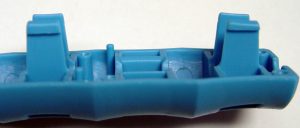 An undercut is a design feature that prevents the plastic part from being ejected from the mold properly. Some examples of undercuts include threads, features, and many holes in side walls. You are wise to avoid these features if possible, because the tool design required to mold with undercuts will significantly increase the price of the mold, as well as the costs of maintaining the mold once it is built.
An undercut is a design feature that prevents the plastic part from being ejected from the mold properly. Some examples of undercuts include threads, features, and many holes in side walls. You are wise to avoid these features if possible, because the tool design required to mold with undercuts will significantly increase the price of the mold, as well as the costs of maintaining the mold once it is built.
Finding out what features to avoid can keep your costs minimal and reduce your time during production. Find out more about this and our other design tips with our guide, Top 10 Design Tips for Plastic Injection Molded Parts.
Tip #8 - Threads with Options
 Threads are a very popular design feature. Molded thread features allow you fasten your plastic part to another plastic part, or to non-plastic products by using common fasteners. In fact, those common fasteners themselves are often molded from plastic. Injection molding thread features is a well-established technology. However, there are some basic facts about injection molding threads that are helpful to know.
Threads are a very popular design feature. Molded thread features allow you fasten your plastic part to another plastic part, or to non-plastic products by using common fasteners. In fact, those common fasteners themselves are often molded from plastic. Injection molding thread features is a well-established technology. However, there are some basic facts about injection molding threads that are helpful to know.
Learn more about the Inside and Outside Thread Options through our Top 10 Design Tips for Plastic Injection Molded Parts guide.
